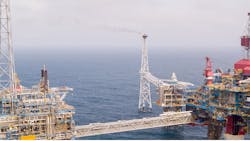Offshore staff
STAVANGER, Norway — The Petroleum Safety Authority Norway (PSA) has completed its investigation of an incident involving a transformer short circuit and a fire pump breakdown on the Sleipner A facility in late October, according to a June 27 PSA news release.
Breaches of the regulations have been identified, and Equinor was given an order.
A short circuit occurred in a transformer on Oct. 29, 2021, on the Equinor-operated Sleipner A facility in the North Sea.
Following the short circuit, fire pumps were activated because smoke was detected. One fire pump broke down during the course of events, with flame detection in a fire-pump room.
During blowdown, flame detection also occurred on Sleipner T.
No personal injuries were suffered from the incident, but it caused material damage and had financial consequences:
- destroyed transformer;
- destruction of flexible coupling and auxiliary hydraulic pump for fire pump B;
- fire pump B out of action;
- destroyed servomechanism for diesel supply shut-off valve to fire pump B;
- loss of power supply to Sleipner B and Gudrun;
- trip of Gina Krog; and
- consequent loss of production.
Potential consequences
The PSA’s assessment is that neither the incident in the transformer room nor the subsequent breakdown in the fire-pump room had a major accident potential.
A larger fire could have broken out in the fire-pump room, but the PSA considers it unlikely that this would have escalated beyond the room.
Direct causes
An internal fault in the high-voltage winding is almost certainly the direct cause of the short circuit in the transformer.
The direct cause of the incident in the fire-pump room is the failure of the flexible coupling installed in the shaft between the auxiliary hydraulic pump and the diesel engine for fire pump B.
Underlying causes
The investigation found several underlying causes, which could have been significant for the incident both with the transformer and in fire-pump room B.
Underlying causes for the transformer incident included design weaknesses and aging. It also included organizational causes; Equinor has considered that it is not necessary to replace this type of transformer in the technical operating life program, although the weakness was known.
Underlying causes of the fire pump breakdown included
- ageing of the rubber element and loss of flexibility in the coupling;
- lack of preventive maintenance;
- inadequate follow up of 2018 lessons-learned report; and
- weaknesses in the system for sharing experience and learning lessons.
Nonconformities
The investigation team identified five nonconformities: maintenance, system for experience-based knowledge and information, barrier understanding and expertise, tagging/signage, and selective disconnection in the event of a short circuit.
Order
The investigation has identified serious breaches of the regulations, and Equinor has therefore been given the following order:
Pursuant to section 69 of the framework regulations on administrative decisions, see sections 45 and 47, paragraphs 1 and 2, of the activities regulations on maintenance and on maintenance program, and sections 58 and 59a of the technical and operational regulations on maintenance and on maintenance program, Equinor is ordered to ensure that failure modes related to flexible couplings attached to diesel-hydraulic fire pump packages are prevented systematically through maintenance programs on offshore facilities and at land plants in Equinor where such equipment is present.
The deadline for compliance with the order is Feb. 1, 2023, and the PSA must be notified when Equinor has complied with the order.
06.30.2022



